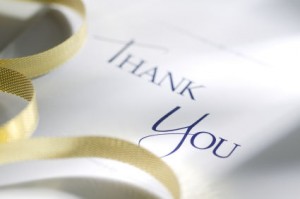 In preparation for my “Wow Your Job Interview” seminar on April 27 (have you signed up yet?) I wanted to talk a bit about the importance of writing thank you notes after your interview.
In preparation for my “Wow Your Job Interview” seminar on April 27 (have you signed up yet?) I wanted to talk a bit about the importance of writing thank you notes after your interview.
If your response to that is to think, “Why? Everybody knows they need to do it…” My response is, “Yes, but do they know how to do it effectively?”
If you’re not sure, here’s how:
First, you need to plan to send both an email and a snail mail thank you note. Why? Well, as noted, everyone is sending at least one but few people are likely sending two—so right there you stand out from the crowd.
The other reason is that unless you have a degree in something fairly granular/high tech/scientific almost everybody has the same skill set. Sending two notes reassures your boss that not only do have the electronic skills necessary, but you also have the ‘soft skill’ of being able to communicate via pen and paper—something that’s well on its way to being a lost art.
And being the master of an increasingly obscure art form is intriguing to others.
But first, a checklist for an effective email note:
- It must arrive within 12 hours.
- My request is that it not begin with, “Thank you so much for meeting me.” As an opening it lacks both originality and confidence. I prefer something along the lines of “It was a pleasure to meet you.”
- Follow that up with a few particulars regarding things you enjoyed hearing or learning from them about the position, the firm or the industry as a whole. As noted, please include particulars. Not, “It was great to hear more about your work.”
- Reference something specific that makes you stand out as a candidate. Don’t go with the vague, “I think I’d be the best person for the job.” Include specifics from your skill set or background experience.
- If you mentioned a person, a book, an article, etc. during the meeting that you felt they would find of interest, mention it again and provide a link to it. This is a “gift with purchase.” This makes you stand out.
- If you made any promises regarding follow up material you would send along, note that again and give a date by when they can expect to receive it.
- Close with something along the lines of, “I look forward to hearing from you.”
- Spell and grammar-check it.
- Print it out and read it on paper before sending it. It’s easier to catch dropped or repeated words when you see them in this format.
Now your snail mail note:
- Bring stationery and a pre-stamped envelope to the interview. Plan to find a quiet spot to write your thank you note immediately on leaving the meeting. Get it written and drop it in the closest mailbox so it will be on your interviewer’s desk in the morning.
- This stationery/note card must be professional– the paper version of a white or blue shirt. Now is not the time to express your individuality with stripes, gilt, aphorisms, or—a la Elle Woods in Legally Blonde—anything scented.
- Draft it out on a scratch pad before you put it down on your stationery so you don’t get halfway through and realize you have no idea what you’re trying to say, or that you don’t have room to complete your thoughts. (But also bring two pieces of stationery in case you make a mistake once you’re ready to write it up ‘officially’.)
- Again, be specific about what you enjoyed learning about the company and how you plan to add value once you are hired.
- Read it back to front to check for misspellings etc—breaking the context helps your eye to catch mistakes.
I guarantee that making the effort to get both notes to your interviewer will ensure you stand out from any other candidate in the mix.
Thank you for reading! I look forward to speaking with you on April 27th.
Frances
